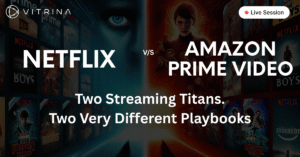The Strategic Imperative of Post-Production Vendor Sourcing in Emerging Markets

Introduction
The film and television industry’s supply chain is undergoing a fundamental shift. As production and distribution models globalize, a new imperative has emerged for senior media executives: strategic post-production vendor sourcing in emerging markets.
For executives responsible for managing budgets and maintaining creative control, the challenge is clear: how to find, vet, and integrate these global partners seamlessly. This guide provides a strategic framework for this complex process.
I will break down the core challenges, outline a data-driven approach to evaluation, and show how a platform like Vitrina can transform this opaque process into a transparent, actionable business function.
Table of content
- The High-Stakes Gamble: Why Sourcing in Emerging Markets Is So Difficult
- What Is Strategic Post-Production Vendor Sourcing?
- The Strategic Imperative for M&E Executives
- The Role of Technology: A Look at the Vitrina Platform
- How Vitrina Transforms Vendor Sourcing into a Competitive Advantage
- Conclusion: A Strategic Shift for the Entertainment Supply Chain
- Frequently Asked Questions
Key Takeaways
| Core Challenge | Inefficient and risky sourcing of post-production vendors in emerging markets due to a lack of verified, centralized data. |
| Strategic Solution | A systematic, data-informed approach to vendor discovery, vetting, and engagement. |
| Vitrina’s Role | The Vitrina platform provides the centralized data and intelligence required to execute this strategy. |
The High-Stakes Gamble: Why Sourcing in Emerging Markets Is So Difficult
The allure of emerging markets lies in the potential for significant cost savings and access to a fresh pool of creative talent. However, the reality of sourcing in these regions is a logistical and informational challenge.
The primary obstacle is the fragmented and opaque nature of the local entertainment supply chain. There is no single, centralized database that provides verified information on vendors.
Executives often spend months manually researching companies, relying on personal recommendations, or attending expensive international markets with no guarantee of finding a suitable partner.
This lack of transparency makes it extremely difficult to conduct proper due diligence. The risk is immense: a vendor may misrepresent their capabilities, lack the financial stability to complete a project, or fail to adhere to critical security protocols, putting valuable IP at risk.
Furthermore, traditional sourcing methods make it impossible to see a company’s full professional network or their complete deal history. Without this context, M&E professionals are essentially making a high-stakes gamble on a partner they know very little about. This is a critical pain point in the entertainment supply chain.
Key Challenges in Sourcing Beyond Traditional Hubs
Despite the clear benefits, sourcing post-production vendors in new territories is fraught with complexity. Executives face a labyrinth of challenges that often remain hidden until a project is underway.
The first hurdle is a critical lack of centralized, verifiable data. The industry’s existing systems for vendor discovery rely heavily on personal networks, word-of-mouth, and fragmented trade show interactions.
This makes it incredibly difficult to conduct proper due diligence, verify a company’s past work, or assess their true capacity. A studio may claim to have worked on a major motion picture, but without a third-party source of truth, that claim is difficult to substantiate. This can lead to significant reputational and financial risk.
Next, there is the challenge of market fragmentation and opacity. The same factors that make emerging markets attractive—the rapid growth and entrepreneurial spirit—also make them difficult to navigate.
A studio might be a major player in its local market but have zero visibility internationally. This lack of transparency means executives are operating with incomplete information, relying on outdated lists or cold emails to fill their pipelines. The result is often a suboptimal choice, or worse, a partnership with an unproven entity.
Finally, there are the logistical and cultural barriers. Differences in time zones, communication styles, legal frameworks, and even the basic language of a contract can derail a project. It’s not just about finding a vendor who can deliver the work; it’s about finding a partner who can integrate into a global workflow.
Navigating these challenges requires more than a sourcing list; it requires a strategic intelligence platform that can cut through the noise and deliver verified insights on a global scale.
A Strategic Framework for Vetting & Sourcing
To overcome the challenges of global sourcing, a systematic, multi-layered framework is essential. This is not about building a static list but about creating a repeatable process for discovering and evaluating partners.
First, you must conduct macro-level market mapping to gain a high-level view of the landscape. This involves identifying which emerging markets are actively investing in their creative economies. Research key government incentives, analyze co-production treaties, and track the volume of film and TV projects originating from a given region.
According to Variety, a number of countries are leveraging aggressive tax rebates and production incentives to attract foreign investment. This data helps narrow down the search from a continent to a specific set of viable countries.
Once a target market is identified, the focus shifts to company and project-level intelligence. This is where you must move beyond a simple web search. I recommend focusing on a company’s actual track record.
What projects have they worked on? What are their recent collaborations? What is their creative and business network? This granular data provides the most accurate signal of a company’s specialization and reliability.
For example, a visual effects house might specialize in CG creatures, while another is known for complex matte paintings. Understanding these nuances is critical to a successful partnership.
After that comes the human element: executive and team profiling. A company is only as good as its leadership. A critical, often-overlooked step is profiling the key decision-makers and creative talent.
Who are the heads of post-production or the lead VFX artists? What is their career history and who are their past collaborators?
This information helps you assess if the team has the necessary experience to handle your project and provides a path for direct, targeted outreach. Sourcing isn’t just about finding a company; it’s about building a relationship with the right people.
Finally, you must ensure continuous monitoring and validation. The global supply chain is dynamic. A vendor’s capacity, reputation, or financial health can change. Therefore, the strategic sourcing process is never truly “over.”
A successful framework includes continuous monitoring of a short-listed group of potential partners, watching for new projects, leadership changes, or public-facing partnerships. This ongoing validation ensures that your pipeline remains current and de-risks future engagements.
Case-in-Point: Market Intelligence in Action
Consider the example of a mid-size U.S. studio looking to expand its pipeline of animation projects. Rather than relying on a traditional scouting trip or a list from a local trade body, a data-driven approach is implemented.
The studio’s strategic sourcing team uses a platform to analyze global production trends and discovers a significant upswing in animated feature and series projects originating from South Korea, driven by both domestic demand and government support.
They note that the market is home to a robust network of character design firms, animation studios, and CGI specialists. This is a clear signal that the region has the necessary infrastructure and expertise.
Using the same intelligence platform, the team filters for animation companies in Seoul with a proven track record on projects similar to their own. They find a handful of studios with verified credits on internationally released animated series.
The platform reveals the specific projects, and critically, the other companies they collaborated with, painting a clear picture of their network and reputation. The team then identifies the head of production and lead animators at each of the top three companies.
They see their past credits and discover they have worked with other major global players. This gives the sourcing team the confidence to reach out directly to the right individuals, bypassing a generic contact form.
With verified data in hand, the studio’s executive team is able to open a conversation from a position of knowledge and authority. They are not asking a vendor to prove themselves; they are discussing how to integrate their respective capabilities for a new project. This process, driven by data, transforms a high-risk vendor search into a strategic business development exercise.
How Vitrina Transforms the Sourcing Process
The strategic framework outlined above is difficult, if not impossible, to execute manually. It requires a constant flow of verified, project-level data that traditional databases cannot provide.
This is precisely the problem Vitrina was built to solve. Vitrina acts as the central intelligence layer for the entire global entertainment supply chain.
For post-production vendor sourcing in emerging markets, Vitrina provides a single source of truth. Its core offering is its Project Tracker, which maps the entire journey of over half a million film and TV projects from development to post-production and beyond.
This allows you to find a company not by what they claim to do, but by what they have actually delivered. You can filter by genre, budget, country of origin, and even specific creative roles, providing an unprecedented level of granularity for discovery.
The platform’s proprietary company profiles go deeper, offering verified project credits, key contacts, and an overview of their creative and business networks.
This functionality directly addresses the primary pain points of the modern executive. Instead of guessing, you can see the verified history of a company. Rather than relying on cold outreach, you can identify and connect with the right decision-maker.
Vitrina’s API and CRM integrations ensure that these insights flow seamlessly into your existing business development workflows, making the process of finding and vetting new partners a core part of your strategic operations, not an ad-hoc chore. To learn more about how to find partners in specific regions, a deep-dive on how to find animation co-production partners in Latin America is a valuable resource.
Conclusion
The globalization of content has made post-production vendor sourcing in emerging markets not just a cost-saving measure but a strategic necessity. The old playbook of relying on personal networks and fragmented data sources is no longer viable.
Success hinges on a new, data-driven approach that allows executives to confidently navigate a complex and opaque landscape.
By leveraging a comprehensive intelligence platform like Vitrina, executives can de-risk the sourcing process, discover vetted partners, and build a more resilient and globally competitive supply chain.
Frequently Asked Questions
The main benefits are access to a diverse and highly skilled talent pool, often at a lower operational cost, and the ability to find specialized creative services that may not be available in traditional hubs. Many of these markets also offer production incentives and tax rebates that make them even more attractive for international co-productions.
Verification is a key challenge. Traditional methods like relying on a vendor’s website or trade show pamphlets are unreliable. A robust solution is to use a centralized data platform like Vitrina that tracks and verifies project-level credits and collaborations for companies globally, providing a single source of truth.
The biggest risk is a lack of visibility and trust. This includes risks related to financial instability, poor communication, or the inability to deliver on a promised project scope. A strategic approach that includes thorough due diligence and continuous monitoring is essential to mitigate these risks.















































